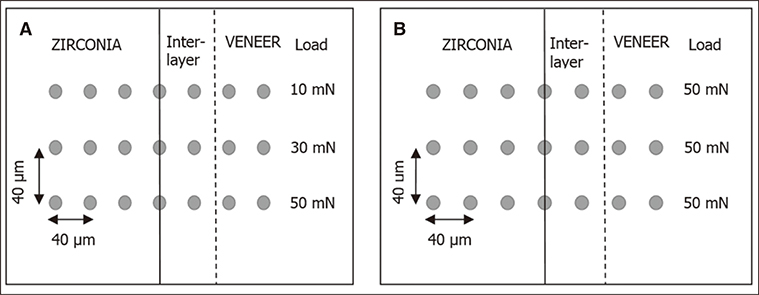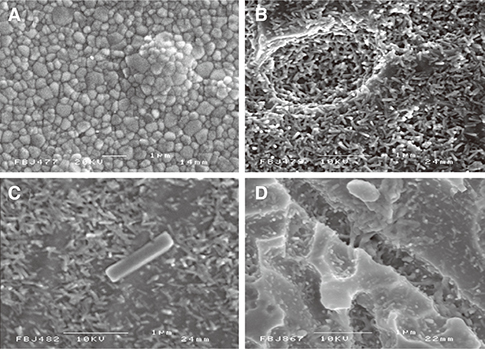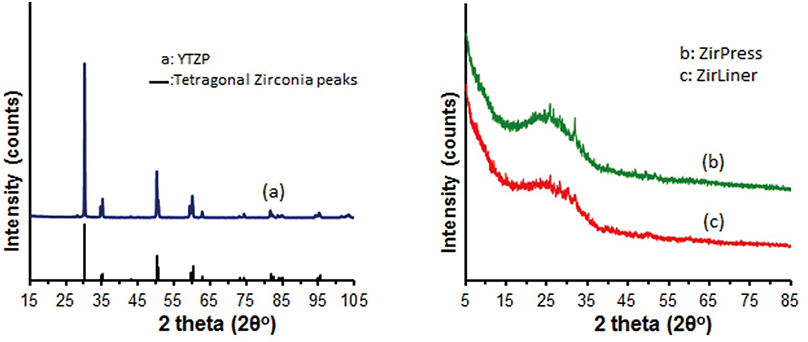J Adv Prosthodont.
2016 Dec;8(6):479-488. 10.4047/jap.2016.8.6.479.
Interfacial modulus mapping of layered dental ceramics using nanoindentation
- Affiliations
-
- 1School of Engineering and Materials Science, Queen Mary University of London, Mile End Road, Mile End, London, UK. a.theocharopoulos@ucc.ie
- 2Cork University Dental School and Hospital, Wilton, Cork, Ireland.
- 3Department of Civil and Mechanical Engineering, University of Glasgow, Glasgow, UK.
- 4Barts & The London School of Dentistry, Centre for Adult Oral Health, Stepney Way, Whitechapel, London, UK.
- KMID: 2382594
- DOI: http://doi.org/10.4047/jap.2016.8.6.479
Abstract
- PURPOSE
The aim of this study was to test the modulus of elasticity (E) across the interfaces of yttria stabilized zirconia (YTZP) / veneer multilayers using nanoindentation.
MATERIALS AND METHODS
YTZP core material (KaVo-Everest, Germany) specimens were either coated with a liner (IPS e.max ZirLiner, Ivoclar-Vivadent) (Type-1) or left as-sintered (Type-2) and subsequently veneered with a pressable glass-ceramic (IPS e.max ZirPress, Ivoclar-Vivadent). A 5 µm (nominal tip diameter) spherical indenter was used with a UMIS CSIRO 2000 (ASI, Canberra, Australia) nanoindenter system to test E across the exposed and polished interfaces of both specimen types. The multiple point load - partial unload method was used for E determination. All materials used were characterized using Scanning Electron Microscopy (SEM) and X - ray powder diffraction (XRD). E mappings of the areas tested were produced from the nanoindentation data.
RESULTS
A significantly (P<.05) lower E value between Type-1 and Type-2 specimens at a distance of 40 µm in the veneer material was associated with the liner. XRD and SEM characterization of the zirconia sample showed a fine grained bulk tetragonal phase. IPS e-max ZirPress and IPS e-max ZirLiner materials were characterized as amorphous.
CONCLUSION
The liner between the YTZP core and the heat pressed veneer may act as a weak link in this dental multilayer due to its significantly (P<.05) lower E. The present study has shown nanoindentation using spherical indentation and the multiple point load - partial unload method to be reliable predictors of E and useful evaluation tools for layered dental ceramic interfaces.
Keyword
MeSH Terms
Figure
Reference
-
1. Raigrodski AJ. Contemporary materials and technologies for all-ceramic fixed partial dentures: a review of the literature. J Prosthet Dent. 2004; 92:557–562.2. Sundh A, Sjögren G. Fracture resistance of all-ceramic zirconia bridges with differing phase stabilizers and quality of sintering. Dent Mater. 2006; 22:778–784.3. Att W, Grigoriadou M, Strub JR. ZrO2 three-unit fixed partial dentures: comparison of failure load before and after exposure to a mastication simulator. J Oral Rehabil. 2007; 34:282–290.4. Heintze SD, Rousson V. Survival of zirconia- and metal-supported fixed dental prostheses: a systematic review. Int J Prosthodont. 2010; 23:493–502.5. Suárez MJ, Lozano JF, Paz Salido M, Martínez F. Three-year clinical evaluation of In-Ceram Zirconia posterior FPDs. Int J Prosthodont. 2004; 17:35–38.6. Taskonak B, Sertgöz A. Two-year clinical evaluation of lithiadisilicate-based all-ceramic crowns and fixed partial dentures. Dent Mater. 2006; 22:1008–1013.7. Sailer I, Fehér A, Filser F, Gauckler LJ, Lüthy H, Hämmerle CH. Five-year clinical results of zirconia frameworks for posterior fixed partial dentures. Int J Prosthodont. 2007; 20:383–388.8. Beuer F, Edelhoff D, Gernet W, Sorensen JA. Three-year clinical prospective evaluation of zirconia-based posterior fixed dental prostheses (FDPs). Clin Oral Investig. 2009; 13:445–451.9. Spies BC, Stampf S, Kohal RJ. Evaluation of Zirconia-Based All-Ceramic Single Crowns and Fixed Dental Prosthesis on Zirconia Implants: 5-Year Results of a Prospective Cohort Study. Clin Implant Dent Relat Res. 2015; 17:1014–1028.10. Kelly JR, Tesk JA, Sorensen JA. Failure of all-ceramic fixed partial dentures in vitro and in vivo: analysis and modeling. J Dent Res. 1995; 74:1253–1258.11. Proos K, Steven G, Swain M, Ironside J. Preliminary studies on the optimum shape of dental bridges. Comput Methods Biomech Biomed Engin. 2000; 4:77–92.12. Guazzato M, Proos K, Sara G, Swain MV. Strength, reliability, and mode of fracture of bilayered porcelain/core ceramics. Int J Prosthodont. 2004; 17:142–149.13. Aboushelib MN, de Jager N, Kleverlaan CJ, Feilzer AJ. Microtensile bond strength of different components of core veneered all-ceramic restorations. Dent Mater. 2005; 21:984–991.14. Aboushelib MN, Kleverlaan CJ, Feilzer AJ. Microtensile bond strength of different components of core veneered all-ceramic restorations. Part II: Zirconia veneering ceramics. Dent Mater. 2006; 22:857–863.15. Guess PC, Kulis A, Witkowski S, Wolkewitz M, Zhang Y, Strub JR. Shear bond strengths between different zirconia cores and veneering ceramics and their susceptibility to thermocycling. Dent Mater. 2008; 24:1556–1567.16. Thompson GA. Influence of relative layer height and testing method on the failure mode and origin in a bilayered dental ceramic composite. Dent Mater. 2000; 16:235–243.17. Guazzato M, Proos K, Quach L, Swain MV. Strength, reliability and mode of fracture of bilayered porcelain/zirconia (Y-TZP) dental ceramics. Biomaterials. 2004; 25:5045–5052.18. Carrier DD, Kelly JR. In-Ceram failure behavior and core-veneer interface quality as influenced by residual infiltration glass. J Prosthodont. 1995; 4:237–242.19. Wakabayashi N, Anusavice KJ. Crack initiation modes in bilayered alumina/porcelain disks as a function of core/veneer thickness ratio and supporting substrate stiffness. J Dent Res. 2000; 79:1398–1404.20. Lawn BR, Pajares A, Zhang Y, Deng Y, Polack MA, Lloyd IK, Rekow ED, Thompson VP. Materials design in the performance of all-ceramic crowns. Biomaterials. 2004; 25:2885–2892.21. Studart AR, Filser F, Kocher P, Lüthy H, Gauckler LJ. Mechanical and fracture behavior of veneer-framework composites for all-ceramic dental bridges. Dent Mater. 2007; 23:115–123.22. Kohorst P, Dittmer MP, Borchers L, Stiesch-Scholz M. Influence of cyclic fatigue in water on the load-bearing capacity of dental bridges made of zirconia. Acta Biomater. 2008; 4:1440–1447.23. Van Meerbeek B, Willems G, Celis JP, Roos JR, Braem M, Lambrechts P, Vanherle G. Assessment by nano-indentation of the hardness and elasticity of the resin-dentin bonding area. J Dent Res. 1993; 72:1434–1442.24. Marshall GW Jr, Balooch M, Gallagher RR, Gansky SA, Marshall SJ. Mechanical properties of the dentinoenamel junction: AFM studies of nanohardness, elastic modulus, and fracture. J Biomed Mater Res. 2001; 54:87–95.25. Angker L, Swain MV. Nanoindentation: Application to dental hard tissue investigations. J Mater Res. 2006; 21:1893–1905.26. He LH, Swain MV. Nanoindentation derived stress-strain properties of dental materials. Dent Mater. 2007; 23:814–821.27. Pongprueksa P, Kuphasuk W, Senawongse P. The elastic moduli across various types of resin/dentin interfaces. Dent Mater. 2008; 24:1102–1106.28. Kirsten A, Parkot D, Raith S, Fischer H. A cusp supporting framework design can decrease critical stresses in veneered molar crowns. Dent Mater. 2014; 30:321–326.29. Kim JW, Bhowmick S, Hermann I, Lawn BR. Transverse fracture of brittle bilayers: relevance to failure of all-ceramic dental crowns. J Biomed Mater Res B Appl Biomater. 2006; 79:58–65.30. Wang G, Zhang S, Bian C, Kong H. Interface toughness of a zirconia-veneer system and the effect of a liner application. J Prosthet Dent. 2014; 112:576–583.31. Field JS, Swain MV. Determining the mechanical properties of small volumes of material from submicrometer spherical indentations. J Mater Res. 1995; 10:101–112.32. Fischer-Cripps AC. Nanoindentation. New York: Springer-Verlag;2004. p. 21–38. p. 69–91.33. Bushby AJ. Nano-indentation using spherical indenters. Nondest Test Eval. 2001; 17:213–234.34. Algueró M, Bushby AJ, Reece MJ. Direct measurement of mechanical properties of (Pb,La)TiO3 ferroelectric thin films using nanoindentation techniques. J Mater Res. 2001; 16:993–1002.35. Bushby AJ, Jennett NM. Determining the area function of spherical indenters for Nanoindentation. MRS Proc: Mater Res Soc. 2001b; Q7.17.1-6.36. Kosmac T, Oblak C, Jevnikar P, Funduk N, Marion L. The effect of surface grinding and sandblasting on flexural strength and reliability of Y-TZP zirconia ceramic. Dent Mater. 1999; 15:426–433.37. Luthardt RG, Holzhüter MS, Rudolph H, Herold V, Walter MH. CAD/CAM-machining effects on Y-TZP zirconia. Dent Mater. 2004; 20:655–662.38. Guazzato M, Quach L, Albakry M, Swain MV. Influence of surface and heat treatments on the flexural strength of Y-TZP dental ceramic. J Dent. 2005; 33:9–18.39. Papanagiotou HP, Morgano SM, Giordano RA, Pober R. In vitro evaluation of low-temperature aging effects and finishing procedures on the flexural strength and structural stability of Y-TZP dental ceramics. J Prosthet Dent. 2006; 96:154–164.40. de Kler M, de Jager N, Meegdes M, van der Zel JM. Influence of thermal expansion mismatch and fatigue loading on phase changes in porcelain veneered Y-TZP zirconia discs. J Oral Rehabil. 2007; 34:841–847.41. Oliver WC, Pharr GM. Measurement of hardness and elastic modulus by instrumented indentation: Advances in understanding and refinements to methodology. J Mater Res. 2004; 19:3–20.42. Fischer-Cripps AC. Critical review of analysis and interpretation of nanoindentation test data. Surf Coat Tech. 2006; 200:4153–4165.43. Guazzato M, Albakry M, Ringer SP, Swain MV. Strength, fracture toughness and microstructure of a selection of all-ceramic materials. Part I. Pressable and alumina glass-infiltrated ceramics. Dent Mater. 2004; 20:441–448.44. Lawn BR, Deng Y, Thompson VP. Use of contact testing in the characterization and design of all-ceramic crownlike layer structures: a review. J Prosthet Dent. 2001; 86:495–510.45. Höland W, Schweiger M, Frank M, Rheinberger V. A comparison of the microstructure and properties of the IPS Empress 2 and the IPS Empress glass-ceramics. J Biomed Mater Res. 2000; 53:297–303.46. Höland W, Rheinberger V, Wegner S, Frank M. Needle-like apatite-leucite glass-ceramic as a base material for the veneering of metal restorations in dentistry. J Mater Sci Mater Med. 2000; 11:11–17.47. Muller R, Abu-Hilal LA, Reinsch S, Holand W. Coarsening of needle-shaped apatite crystals in SiO2 - Al2O3 - Na2O -K2O - CaO - P2O5 - F glass. J Mater Sci. 1999; 34:65–69.48. Esposito L, Bellosi A. Interfacial characteristics in ceramic joining with glass interlayers. Ceram Eng Sci Proc (USA). 2002; 23:793–800.49. Swab JJ. Low temperature degradation of Y-TZP materials. J Mater Sci. 1991; 26:6706–6714.50. Dukino RD, Swain MV. Comparative measurement of indentation fracture toughness with Berkovich and Vickers indenters. J Am Ceram Soc. 1992; 75:3299–3304.
- Full Text Links
- Actions
-
Cited
- CITED
-
- Close
- Share
- Similar articles
-
- Comparison of the elastic modulus among three dentin adhesives before and after thermocycling
- Influence of investment/ceramic interaction layer on interfacial toughness of body ceramic bonded to lithia-based ceramic
- The effect of repeated firings on the color change and surface roughness of dental ceramics
- Biaxial flexural strength of bilayered zirconia using various veneering ceramics
- Silver Diamine Fluoride Compound for Dental Caries and Its Characterisation Using Microscopic Computed Tomography and Nanoindentation







